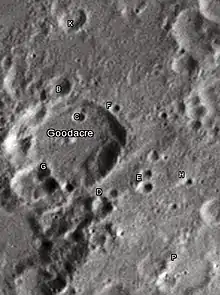Goodacre (crater)
Goodacre is a lunar impact crater. It is located in the rugged southern highlands on the Moon's near side, and is attached to the north-northeastern part of the exterior of Gemma Frisius, a heavily worn and much larger formation. About two crater diameters to the north of Goodacre lies Pontanus.
 Lunar Orbiter 4 image | |
| Coordinates | 32.7°S 14.1°E |
|---|---|
| Diameter | 46 km |
| Depth | 3.2 km |
| Colongitude | 346° at sunrise |
| Eponym | Walter Goodacre |
The crater is named after British selenographer Walter Goodacre.[1]
The outer rim of this crater formation has become eroded by smaller impacts, and is heavily damaged along the southern side. The somewhat distorted satellite crater Goodacre G lies across the co-joined rims of Goodacre and Gemma Frisius. The interior floor has a small central rise and there is a small crater near the northern inner wall. A trace of ray material from Tycho lies along the southwest rim and forms a wispy line that crosses the central peak.
Satellite craters

By convention these features are identified on lunar maps by placing the letter on the side of the crater midpoint that is closest to Goodacre.
| Goodacre | Latitude | Longitude | Diameter |
|---|---|---|---|
| B | 31.8° S | 13.7° E | 9 km |
| C | 32.3° S | 14.2° E | 5 km |
| D | 33.4° S | 15.0° E | 8 km |
| E | 32.9° S | 15.5° E | 6 km |
| F | 31.9° S | 14.6° E | 5 km |
| G | 33.3° S | 13.9° E | 16 km |
| H | 32.8° S | 16.1° E | 4 km |
| K | 30.9° S | 13.5° E | 11 km |
| P | 34.0° S | 16.7° E | 22 km |
References
- "Goodacre (crater)". Gazetteer of Planetary Nomenclature. USGS Astrogeology Research Program.
- Andersson, L. E.; Whitaker, E. A. (1982). NASA Catalogue of Lunar Nomenclature. NASA RP-1097.CS1 maint: ref=harv (link)
- Bussey, B.; Spudis, P. (2004). The Clementine Atlas of the Moon. New York: Cambridge University Press. ISBN 978-0-521-81528-4.CS1 maint: ref=harv (link)
- Cocks, Elijah E.; Cocks, Josiah C. (1995). Who's Who on the Moon: A Biographical Dictionary of Lunar Nomenclature. Tudor Publishers. ISBN 978-0-936389-27-1.CS1 maint: ref=harv (link)
- McDowell, Jonathan (July 15, 2007). "Lunar Nomenclature". Jonathan's Space Report. Retrieved 2007-10-24.CS1 maint: ref=harv (link)
- Menzel, D. H.; Minnaert, M.; Levin, B.; Dollfus, A.; Bell, B. (1971). "Report on Lunar Nomenclature by the Working Group of Commission 17 of the IAU". Space Science Reviews. 12 (2): 136–186. Bibcode:1971SSRv...12..136M. doi:10.1007/BF00171763.CS1 maint: ref=harv (link)
- Moore, Patrick (2001). On the Moon. Sterling Publishing Co. ISBN 978-0-304-35469-6.CS1 maint: ref=harv (link)
- Price, Fred W. (1988). The Moon Observer's Handbook. Cambridge University Press. ISBN 978-0-521-33500-3.CS1 maint: ref=harv (link)
- Rükl, Antonín (1990). Atlas of the Moon. Kalmbach Books. ISBN 978-0-913135-17-4.CS1 maint: ref=harv (link)
- Webb, Rev. T. W. (1962). Celestial Objects for Common Telescopes (6th revised ed.). Dover. ISBN 978-0-486-20917-3.CS1 maint: ref=harv (link)
- Whitaker, Ewen A. (1999). Mapping and Naming the Moon. Cambridge University Press. ISBN 978-0-521-62248-6.CS1 maint: ref=harv (link)
- Wlasuk, Peter T. (2000). Observing the Moon. Springer. ISBN 978-1-85233-193-1.CS1 maint: ref=harv (link)
External links
 Media related to Goodacre (crater) at Wikimedia Commons
Media related to Goodacre (crater) at Wikimedia Commons- Wood, Chuck (July 15, 2007). "An Author Where He Belongs". Lunar Photo of the Day. Archived from the original on September 27, 2007. Retrieved 2007-07-16.